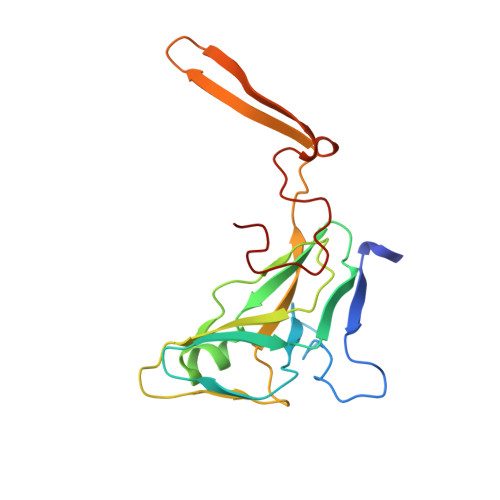The dUTPase of white spot syndrome virus assembles its active sites in a noncanonical manner.
Zang, K., Li, F., Ma, Q.(2018) J Biol Chem 293: 1088-1099
- PubMed: 29187596
- DOI: https://doi.org/10.1074/jbc.M117.815266
- Primary Citation of Related Structures:
5Y5O, 5Y5P, 5Y5Q - PubMed Abstract:
dUTPases are essential enzymes for maintaining genome integrity and have recently been shown to play moonlighting roles when containing extra sequences. Interestingly, the trimeric dUTPase of white spot syndrome virus (wDUT) harbors a sequence insert at the position preceding the C-terminal catalytic motif V (pre-V insert), rarely seen in other dUTPases. However, whether this extra sequence endows wDUT with additional properties is unknown. Herein, we present the crystal structures of wDUT in both ligand-free and ligand-bound forms. We observed that the pre-V insert in wDUT forms an unusual β-hairpin structure in the domain-swapping region and thereby facilitates a unique orientation of the adjacent C-terminal segment, positioning the catalytic motif V onto the active site of its own subunit instead of a third subunit. Consequently, wDUT employs two-subunit active sites, unlike the widely accepted paradigm that the active site of trimeric dUTPase is contributed by all three subunits. According to results from local structural comparisons, the active-site configuration of wDUT is similar to that of known dUTPases. However, we also found that residues in the second-shell region of the active site are reconfigured in wDUT as an adaption to its unique C-terminal orientation. We also show that deletion of the pre-V insert significantly reduces wDUT's enzymatic activity and thermal stability. We hypothesize that this rare structural arrangement confers additional functionality to wDUT. In conclusion, our study expands the structural diversity in the conserved dUTPase family and illustrates how sequence insertion and amino acid substitution drive protein evolution cooperatively.
Organizational Affiliation:
From the Key Laboratory of Experimental Marine Biology, Institute of Oceanology, Chinese Academy of Sciences, Nanhai Road 7, Qingdao 266071, China.

















